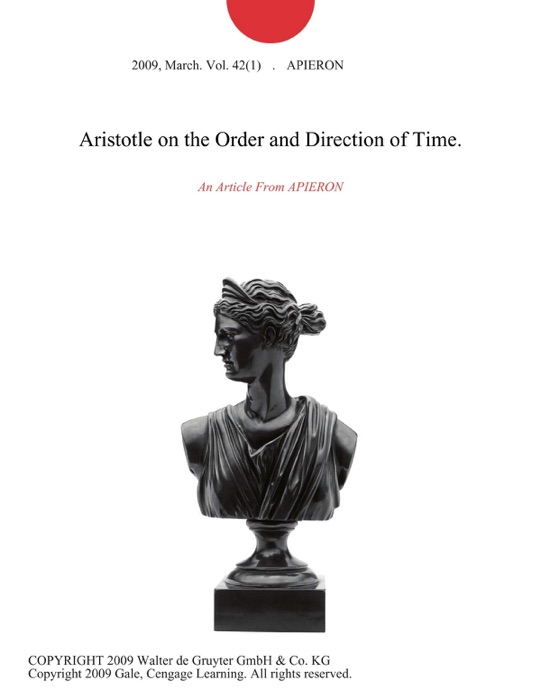[Download] "Aristotle on the Order and Direction of Time." by APIERON * eBook PDF Kindle ePub Free

eBook details
- Title: Aristotle on the Order and Direction of Time.
- Author : APIERON
- Release Date : January 01, 2009
- Genre: Religion & Spirituality,Books,
- Pages : * pages
- Size : 228 KB
Description
In Book IV, Chapter 11 of the Physics, Aristotle claims that 'the before and after' exists in time because it also exists in change, and it exists in change because it also exists in magnitude, and, further, that 'time follows change' and 'change follows magnitude'. (1) This is usually taken to mean that moments of time correspond to momentary stages of changes, and that momentary stages of changes correspond to points in magnitudes, so that time derives its 'before and after' from that of change, and change from that of magnitude. (2) But this is widely thought to land Aristotle in the following difficulty: If Socrates walks between points A and C, for instance, he can either proceed from point A to point C, or from point C to point A, but it seems that one cannot decide which of these two directions apply to the motion without importing a time reference. In other words, to say that Socrates moves from point A to point C is just to say that he is at point A prior to the time at which he is at point C. (3) So the derivation of the before and after in time is circular because we cannot specify the direction of a change without invoking the temporal relations of its stages. Similarly, the derivation of the before and after in change is circular because we cannot even give sense to the notion of a direction of a magnitude without designating it as the path of some change. In her book Time for Aristotle, Ursula Coope says, 'the fact that this view is so obviously unsatisfactory should lead us to question the interpretation that attributes it to Aristotle.' (4) I agree. Coope proposes two interpretations to acquit Aristotle of these circularities. First she suggests that Aristotle might be interested in accounting for the orders of time and change but not their directions. In the example I just gave, suppose that Socrates walks between points A and C, but through point B this time, and that 'O', 'P', and 'Q' denote the kinetic stages Socrates being at point A, Socrates being at point B, and Socrates being at point C respectively. We can give the order of the motion by claiming that P is between O and Q, but give its direction by claiming that Socrates proceeds from O through P to Q. (5) Thus, the direction of a change is an asymmetry, i.e., the change proceeding in the sequence O-P-Q, but not Q-P-O, while its order is not, since being P being between O and Q is consistent with the change proceeding in either of these directions. On this interpretation, the 'before and after in time' depends upon the 'before and after in change' and the 'before and after in change' depends upon the 'before and after in magnitude' only when the series of points, momentary stages, and instants are each viewed as having orders but not directions or asymmetries. (6) This dissolves the circularities by making it no longer necessary to determine the direction of any of the series, and seems plausible in the case of magnitude, since assigning one direction or another to a magnitude seems, prima facie, arbitrary. But it is less attractive in the cases of change and time, which do possess obvious asymmetries that Aristotle gives considerable attention to elsewhere. (7) So Coope proposes a second interpretation that at least attributes to Aristotle an explanation of asymmetries in time and change. In the sequel, I will focus on this second interpretation, and leave aside the first. I will consider criticisms of this interpretation by Stephen Makin, add criticisms of my own, and propose an alternative interpretation that I think fares better. Finally, having established that Aristotle's derivations of the directions of time and change are not viciously circular, I will consider the separate, but related problem of how the temporal orders and directions derived from individual changes can together constitute a single, globally consistent order and direction of time.
Post a Comment for "[Download] "Aristotle on the Order and Direction of Time." by APIERON * eBook PDF Kindle ePub Free"